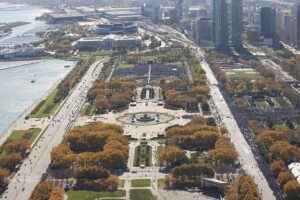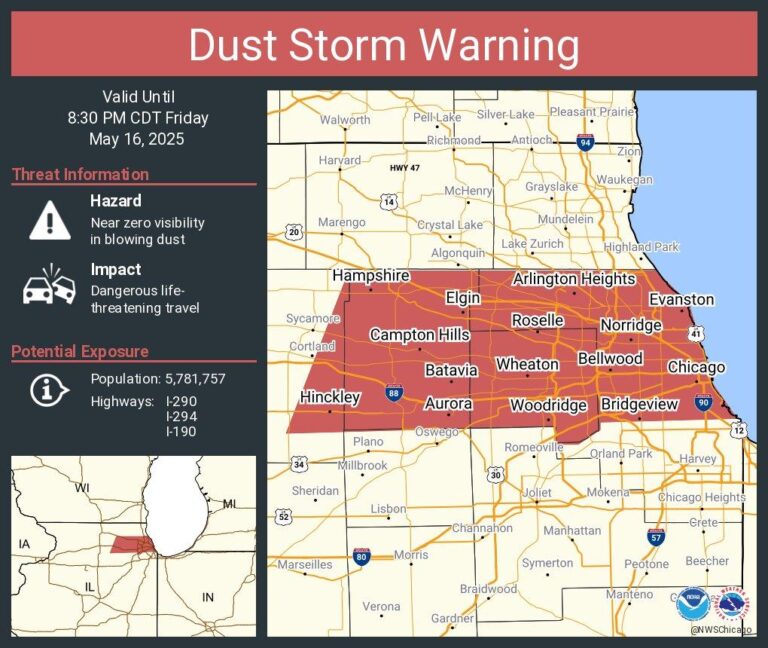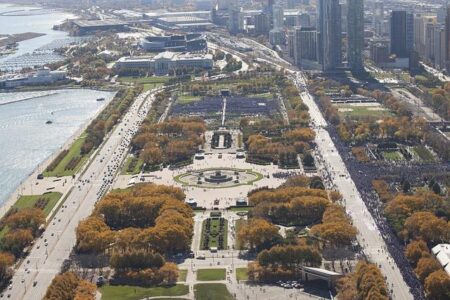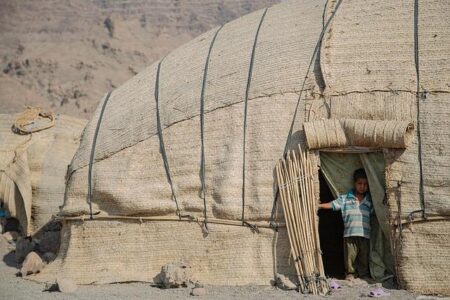Chicago’s Historic Dust Storm Warning: Understanding the Causes and Preparing for the Future
Chicago’s First-Ever Dust Storm Alert: A New Meteorological Milestone
For the first time in its recorded history, Chicago has been placed under a dust storm warning, a advancement that has caught both residents and weather experts by surprise. This extraordinary event signals a shift in the region’s climatic behavior, driven by a unique blend of environmental and atmospheric conditions. Specialists attribute the emergence of this dust storm to a combination of prolonged drought across the Midwest, unusually strong winds sweeping the plains, and disturbances from urban construction activities that loosened soil surfaces.
Several critical elements contributed to this rare warning:
- Extended drought periods: Months of dry weather have left agricultural fields and open lands vulnerable to wind erosion.
- Intense wind gusts: Powerful winds moving across the prairie regions lifted dust particles and carried them into Chicago’s airspace.
- Construction and land development: Ongoing building projects created additional sources of loose soil, exacerbating dust availability.
| Cause | Effect | Timeframe |
|---|---|---|
| Severe drought | Exposed, dry soil surfaces | Several months |
| Strong winds | Dust particles lifted into the atmosphere | Hours to days |
| Urban construction | Additional dust sources | Ongoing |
Atmospheric Dynamics Behind Chicago’s Dust Storm Phenomenon
The convergence of several meteorological factors created the perfect storm for Chicago’s dust storm warning. A potent low-pressure system over the Great Plains generated sustained high winds, which, combined with an exceptionally dry air mass, mobilized vast quantities of dust and soil particles.This event was further intensified by atmospheric conditions that trapped dust near the surface, increasing its concentration in the city’s air.
Primary meteorological drivers included:
- Wind shear at multiple altitudes: Varied wind speeds at different atmospheric layers facilitated the lifting and long-distance transport of dust.
- Extremely dry soil conditions: The Midwest’s soil moisture levels plummeted to historic lows, making it easier for dust to detach and become airborne.
- Temperature anomalies: Daytime temperatures soared above average, promoting atmospheric mixing that kept dust suspended.
- Inversion layers: A shallow temperature inversion prevented dust from dispersing upward,concentrating it near ground level.
| Meteorological Factor | Details | Effect |
|---|---|---|
| Wind Speeds | Sustained gusts between 35-45 mph | Elevated dust into the atmosphere |
| Soil Moisture | Record low moisture across the Midwest | Facilitated dust particle detachment |
| Temperature | Above-average daytime highs | Enhanced vertical air mixing |
Health Risks and Environmental Consequences of the Dust Storm
The dust storm warning has sparked serious concerns about public health, as airborne dust particles can aggravate respiratory illnesses such as asthma, bronchitis, and chronic obstructive pulmonary disease (COPD). Sensitive populations-including children,seniors,and individuals with preexisting respiratory conditions-face heightened vulnerability. Health officials recommend limiting outdoor exposure, utilizing air filtration systems indoors, and wearing protective masks when outside during dust events.
In addition to health impacts,the dust storm has disrupted Chicago’s urban surroundings by reducing visibility and degrading air quality. Early environmental data reveal:
- Visibility reduction: Sightlines decreased by up to 60%, complicating transportation safety.
- Air quality deterioration: Particulate matter (PM10) concentrations surged,reaching levels deemed unhealthy.
- Surface dust accumulation: Dust settled on streets and buildings, necessitating increased cleaning efforts.
| Pollutant | Typical Levels (µg/m³) | Levels During Dust Storm (µg/m³) | Health Effects |
|---|---|---|---|
| PM10 | 20-50 | 150-200 | Irritation of respiratory tract, decreased lung function |
| PM2.5 | 10-35 | 80-120 | Elevated risk of cardiovascular and pulmonary diseases |
| Visibility (miles) | 10+ | 4-6 | Compromised driving safety and outdoor activities |
Strategies for Chicago Residents and Officials to Combat Future Dust Storms
In light of this unprecedented dust storm warning,it is indeed essential for both Chicago’s citizens and municipal authorities to adopt extensive preparedness measures. Individuals should assemble emergency kits stocked with essentials such as bottled water, protective masks, and first aid supplies. Staying updated through official weather channels and minimizing outdoor exposure during dust events are crucial steps. Homes should be sealed to prevent dust infiltration, and special care must be taken to protect vulnerable groups like children, the elderly, and those with respiratory ailments.
On the governmental side, a multi-faceted approach is necessary to reduce the impact of future dust storms:
- Upgrading early warning systems to deliver timely, accurate alerts.
- Providing specialized training for emergency responders on dust storm hazards and safety protocols.
- Launching urban greening and soil stabilization projects to reduce dust generation.
| Preparedness Initiative | Priority | Responsible Agency |
|---|---|---|
| Public Education Campaigns | High | Chicago Department of Public Health |
| Emergency Shelter Coordination | Medium | Office of Emergency Management |
| Vegetation and Soil Stabilization | High | Department of Environment and Parks |
Conclusion: Adapting to Emerging Climate Challenges in Chicago
Chicago’s inaugural dust storm warning underscores the increasing influence of shifting climate patterns and environmental stressors on urban centers. The interplay of drought, strong winds, and disturbed soils has created conditions once thought unlikely in this region. While dust storms remain infrequent, this event serves as a wake-up call for enhanced vigilance and preparedness. Residents are encouraged to stay informed and take protective actions during such episodes,while city officials continue to develop strategies to bolster resilience against future atmospheric threats.






